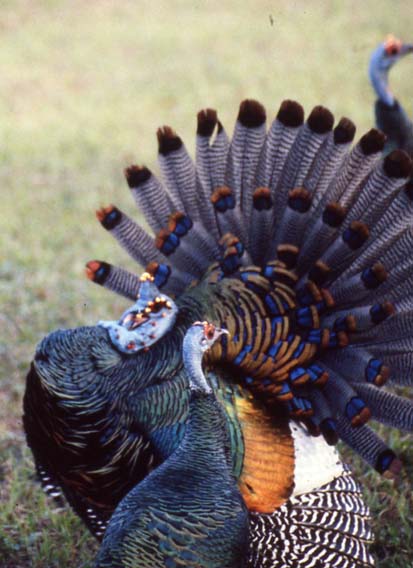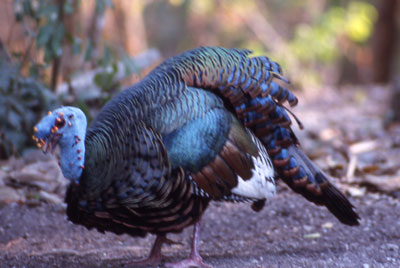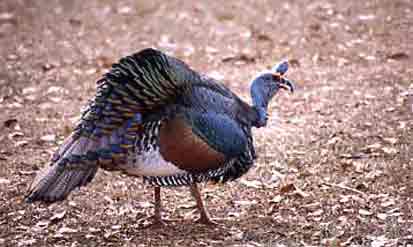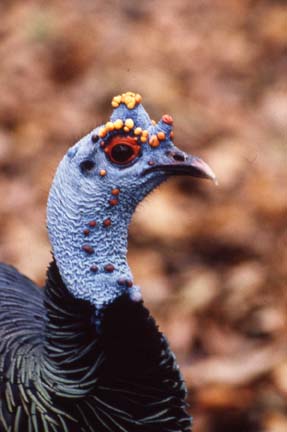Based on observations of the ocellated turkey made by Lovett Williams in Guatemala and the Yucatan of Mexico.
When the male ocellated turkey performs prenuptial strutting behavior, he does not assume the same postures as does a strutting wild turkey of North America. This should be of special interest to artists and taxidermists. Hunters are welcome to print out hard copies of this material to give to their taxidermists.
Wing and Tail Positions
The male
ocellated turkey begins his strutting routine by dipping his head to the
ground and wagging his raised tail vigorously from side to side. He then
abruptly lifts his head, spreads open his tail, and begins his frenzied
strutting routine.
As he struts, his attention is directed toward one particular hen. If the hen is stationery, the male moves excitedly back and forth in a semi-circle within 8 feet of the hen with his open tail tilted so that the top (dorsal) side is toward her. His wing on the side away from the hen is extended nearly, but not quite, to the ground and is vibrated rapidly and noisily while the wing on the hen's side is extended stiffly and dragged against the ground but not fluttered as the other wing is. If the hen moves, the male moves quickly along with her while continuing to strut. When he stops moving, both wings sometimes touch the ground momentarily.

The strutting gobbler orients his tail to display its "eyes" to the hen.
Both the wild turkey and ocellated turkey ruff out their breast feathers when strutting. The wild turkey's feathers are ruffed rather uniformly to make a large, rounded breast that shines with reflected light. The ocellated gobbler ventilates his front breast feathers quite differently. The middle breast feathers stick almost straight forward creating a large triangular area, which, when viewed from the front, does not reflect light but creates a black triangle. The upper edge of the ventilated feathers looks much like the prow of a boat.

When ventilated, the breast feathers in front do not reflect light.
The strutting ocellated gobbler's head is laid in his plumage close against his back, similar to the posture of the North American wild turkey, but the forward projection of his breast feathers makes his head appear to be farther back toward the tail than does the head of the strutting wild turkey gobbler.
From time to time during the strutting display, the gobbler will approach the hen on tip-toes, standing as tall as possible with his neck stretched high above the hen in an intimidating way. While in that posture, he issues a low-pitched, very low-volume moan "oooooo" like a sound popularly attributed to ghosts and goblins. After issuing this weird sound, he returns to his normal strutting posture. The "ooooo" call cannot be heard with the naked ear--I have heard and recorded it on a sensitive shotgun mic only from a blind within 20 feet of the strutting turkey.

A strutting
ocellated gobbler in the "intimidation" posture while issuing
the low volume "oooooo" call.

The outward ventilated breast feathers form a sharp upper edge and create
a dark triangle in front.
Non-strutting Postures
and Skin Colors
During the
mating season, ocellated turkey gobblers often stand in a unique "hunched"
body posture but at other seasons their carriage is more streamlined and
quite similar to the wild turkey's.

Adult
male in "hunched" body posture.

A
gobbler standing "hunched backed,"
a posture commonly assumed during the mating season.
The ocellated turkey's scaly lower legs are scarlet rather than the deep red of the North American turkey and the smooth skin of the head and neck is bluish-green ("cornflowerblue") with numerous small spherical, caruncles of various size ranging in color from orange-red to dark-orange. There are no noticeable differences in the skin color of males and females nor any significant seasonal color differences. The head and neck of the ocellated turkey does not change color to reflect mood as does the head and neck of the North American wild turkey gobbler.
The
Male's Crown
On the very top of the adult male's head is a soft, rectangular appendage
that resembles a crown, topped with a cluster of small round, yellow caruncles.
This appendage is enlarged during the mating season. The elevated crown
is much smaller in jakes and absent in females but both genders and all
age classes of grown ocellated turkeys have the round, golden-orange caruncles.

The head of an adult male showing the well-developed crown on top
and the orange caruncles on the head and neck.
Suggested Models
A good strutting
model for taxidermists and artists would be to position one wing to the
ground, the other about three inches above the ground. Both wings should
be about one inch out from the sides and the spread tail should be oriented
toward the side with the wing that touches the ground as through a hen
stood in that direction. The middle breast feathers should be ventilated
outward and the feathers of the upper breast should form a sharp upper
front edge where they come together forward of the turkey's head. The
head should be in the approximate middle of the back and almost buried
in the back feathers as depicted in the photograph.
For non-strutting postures, such as on a roosting limb or merely standing alone, you can follow the basic postures of the North American wild turkey gobbler including the enlarged breast caused by the breast sponge of spring mating season.